Pronunciation:
(KAY-neez vee-NAT-uh-sigh)Abbreviation:
CVnGenitive:
Canum VenaticorumRight Ascension:
13 hoursDeclination:
40 degreesArea in Square Degrees:
456Crosses Meridian:
9 PM, May 20Visible Between Latitudes:
90 and -40 degreesThe constellation Canes Venatici, the hunting dogs, is visible in the Northern Hemisphere in spring and summer. It is visible at latitudes between 90 degrees and -40 degrees. It is a medium-sized constellation covering 465 square degrees of the sky. It ranks 38th in size among the 88 constellations in the night sky. It is bordered by Ursa Major to the north and west, Coma Berenices to the south, and Boötes to the east.
Canes Venatici was originally included in the constellation Ursa Major by the Greek astronomer Ptolemy in the second century. The constellation’s name means “hunting dogs” in Latin. There are no myths associated with this constellation. It represents the hunting dogs, Asterion and Chara, held by Boötes as he hunts for the bears Ursa Major and Ursa Minor in the night sky. The two dogs were first depicted with Boötes on a map by the German astronomer Peter Apian in 1533. The stars were separated out by the Polish astronomer Johannes Hevelius in 1687. He took the faint stars under the bear’s tail and formed the modern constellation Canes Venatici.
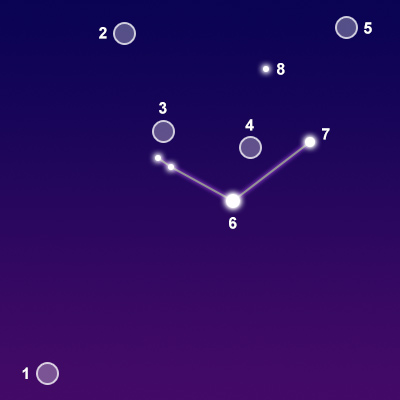
points of interest below © Sea and Sky
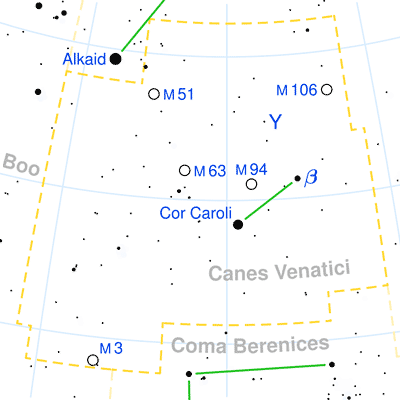
© Torsten Bronger CC BY-SA 3.0
2
3
4
5
6
7
8
M51
M63
M94
M106
Cor Caroli
Chara
La Superba
Whirlpool Galaxy
Sunflower Galaxy
N/A
N/A
"Heart of Charles"
"Dear"
"The Gorgeous"
Spiral Galaxy
Spiral Galaxy
Spiral Galaxy
Spiral Galaxy
Binary Star System
Yellow-White Subgiant Star
Red Variable Star
8.40
8.60
8.20
8.40
2.90
4.26
5.42
Canes Venatici is composed mainly of faint stars. Only one star in this constellation is brighter than magnitude 4. Cor Caroli is the brightest star with a visual magnitude of 2.90. It is a binary star system located approximately 110 light years from Earth. Chara is the second brightest star with a magnitude of only 4.26. It is a yellow-white subgiant star that lies about 27 light years away. The third brightest star is La Superba with a magnitude of only 5.42. It is a red variable star that is famous for being one of the reddest stars in the sky. It lies about 711 light years from Earth.
Canes Venatici contains five Messier objects. All of these are spiral galaxies except for M3, which is a globular star cluster. The most famous of these is M51, also known as the Whirlpool Galaxy. It is one of the most beautiful face-on spiral galaxies in the sky, with dark dust lanes and red nebulas easily visible. M63, also known as the Sunflower Galaxy, is another beautiful spiral galaxy. M94 is face-on spiral galaxy with easily-recognizable dark dust lanes. M106 is yet another spiral galaxy with an active nucleus classified as a Type 2 Seyfert with a supermassive black hole at its center. M3 is a globular star cluster that contains over 500,000 individual stars. Canes Venatici also contains a small group of galaxies known as the M51 group. This group contains M51 and M63 as well as a number of much more dim galaxies which can only be seen with a large telescope.
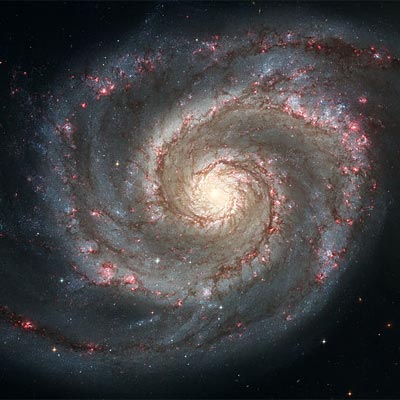
the Hubble Space Telescope
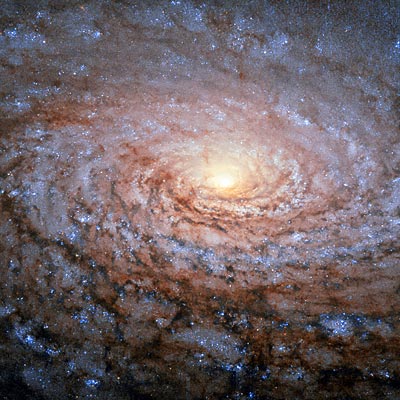
© ESA/Hubble & NASA / CC BY 3.0

the Hubble Space Telescope
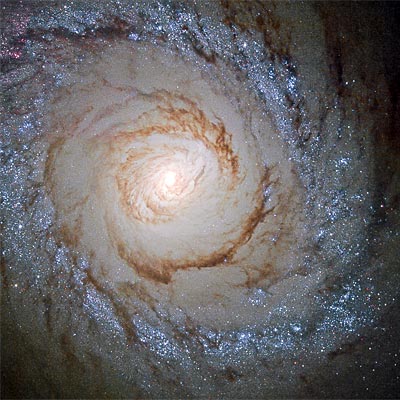
© ESA/Hubble & NASA / CC BY 3.0



